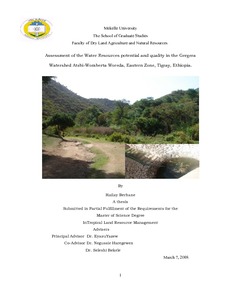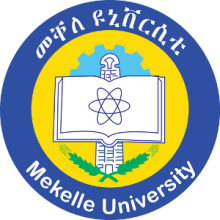Resource information
Water demand is increasing with population growth and agricultural practice leading into industrialization. Hence, the information on spatial and temporal availability of water will be helpful for the optimum utilization and sustainability of water resource. Seasonal and Spatial pattern of water availability was computed based on the water balance to facilitate better management of available water resources. The study was conducted on gergera watershed where in between -39º 30' – 39º 45' E and 13º 30' – 13º 45' N with an area extent of 8.02 km2. Various maps, such as location map, geological map, soil map, land use map and drainage map of the area were produced using field survey data as well as topo maps.the dominant lithologies those out crop in the area are Metavolcanic (phyllite), sand stone (Adigrat and Enthicho) and alluvial deposited. Currently, seven land use classes were identified in the area. These are grazing, cultivated, settlement, forest, bushes and shrubs, swamp and bare land. Based on USDA soil textural classification scheme, the soil coverage of the area classified in to four different soil classes:-sand, sandy loam, sandy clay and sandy clay loam. Secondary data concerning the climate of the area were obtained from Wukro and Senkata metrological stations. Rain fall distribution of the area is monomodal having one dry and rainy season with seven dry and three rainy seasons. The mean annual rain fall of the area is found to be 609.7mm with an average temperature of 17.4oc which makes the area to fall under temperate zone. Evapotranspiration was determined by using FAO-Penman Monteith method. Accordingly the annual evapotranspiration is found to be 0.7129*106m3. The net runoff is determined using a curve number method and was found to be 1.86*106m3.and net infiltration that recharge the ground water system. It has obtained by using water balance concept and equals 0.7308*106m3.The geology of the area was mapped at a scale of 1:50000 and it constituent’s basement rock, sandstone and alluvial deposits (i.e. gravel, sand, and clay) units. Faults, fractures and foliations are the main geological structures. Thus, units and structures control the groundwater flow direction of the study area.In the hydrogeological investigation around 68 hands dug wells inventoried out of these only 48 were productive at present the rest are dried and collapsed. Based on the pumping test data analysis conducted mainly on 6 representative wells, Accordingly, the potential of many of the aquifers was found to be low to moderate due to inadequate partially penetration of the water-bearing formations.



